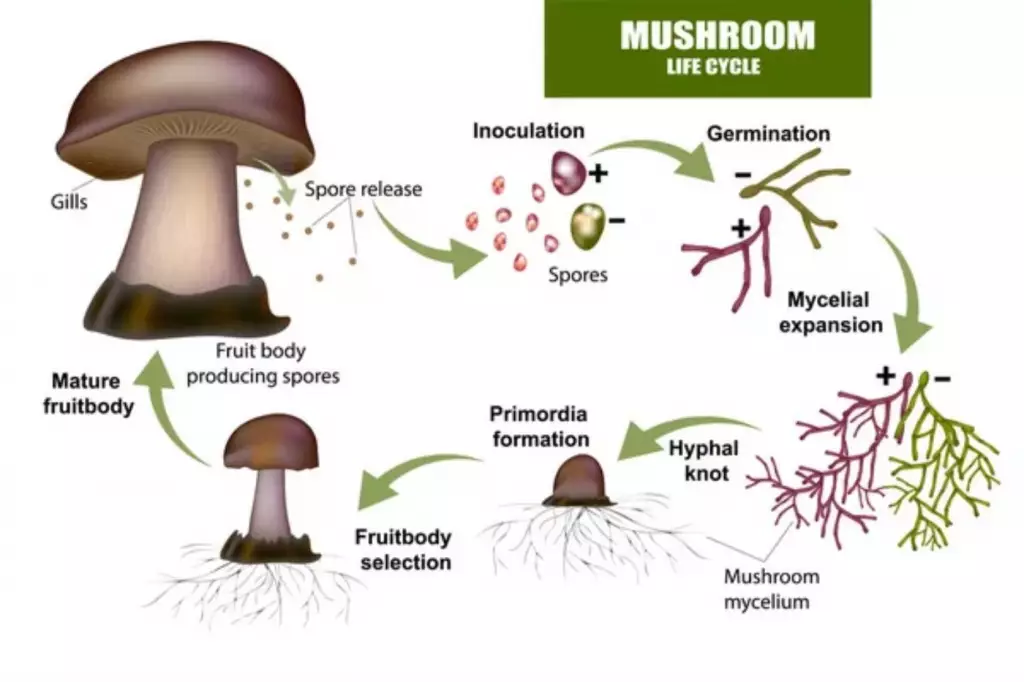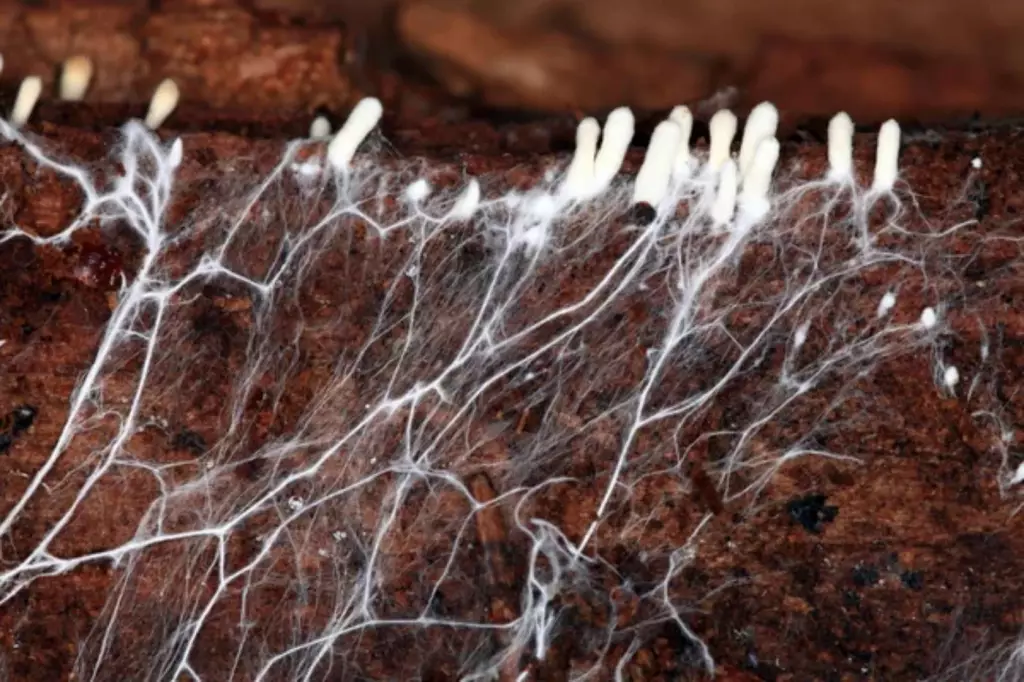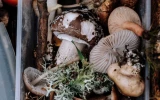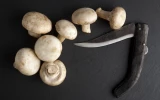Stages of Mushroom Growth Explained (Timeline & Diagram)
Mushrooms are unique life forms that are neither classified as plants nor animals. They have a distinct life cycle where they undergo stages of development to become mature mushrooms. This article gives a detailed explanation of the stages of mushroom growth that will help you understand its life cycle.
The growth of mushrooms starts with spore germination, followed by mycelial expansion, hyphal knot and primordia formation, fruitbody selection and maturation, and finally, spore release. Starting as a fungal spore, mushrooms mature into a fruiting body that will release the new spores and start the cycle over again.
Knowing the life cycle of mushrooms as a cultivator is beneficial for your business. It will allow you to meet the needs of your mushrooms at different stages of their growth, producing high-quality fruiting bodies. Let's dive into a more detailed explanation of each stage of mushroom growth below.
Summary
- The stages of mushroom growth start with spores that grow into hyphae, which form the mycelia. The mycelia expand and form hyphal knots, which give rise to pinheads. These pinheads will grow into mature mushrooms.
- The life cycle of mushrooms revolves around its two most important parts: the fruiting body and the mycelium.
- The growth of mushrooms starts with spore germination and ends with spore release.

On this page:
Detailed Explanation of the Mushroom Growth Stages
The mushroom life span differs between fungi species. One complete life cycle could take one week, one month, or sometimes more than a month.
The growth of mushrooms is summarized as follows:
- the spores released by the fruiting bodies combine and germinate to form the hyphae
- the fused hyphae will form the mycelium
- when mycelium condenses, it forms the hyphal knot
- the hyphal knot will give rise to the primordial, the young mushroom
- the primordia soon develops into a mature mushroom
- the mature mushrooms release the spores
To fully understand the growth of mushrooms, let’s first identify two of the most important parts of the fungi where the cycle revolves around. These parts are called the fruiting body and the mushroom mycelium.

The fruiting body is what we recognize as the mushrooms. They are the visible part of the whole fungus, which grows prominently above the ground. You may think of them as the literal fruit, as compared to the apples on an apple tree.
However, as fruits, mushrooms don’t have seeds, instead, they have tiny spores, which are used to continue their life cycle all over again. The function of the fruiting bodies is to produce these millions of tiny spores for reproduction.
Aside from the fruiting bodies, another important part to take note of in the life cycle of mushrooms is their mycelia. The mushroom mycelium is the digestor of organic matter, so the mushrooms can access nutrients in the substrate that will contribute to their growth.
The mushroom mycelium has strong enzymatic capabilities that break down even the most complex molecules. They also developed strong immunity against hostile environments, which is why they have the highest endurance of any part of the fungus.
Since we now know the two most important parts of the mushroom life cycle, here’s a detailed explanation of each growing stage:

The germination phase is the first stage of the growth of mushrooms
When mushrooms mature, they will release spores, which are their reproductive units. The growth stage of mushrooms begins when these spores germinate. Germination is the process by which two different compatible spores grow together and develop into multicellular fungal filaments called "hyphae."
When spores are released by the mushrooms, they are carried via wind or water until they settle on a surface where they sense favorable conditions for their growth. From there, they will germinate and develop a germ tube.
The germ tube differentiates and grows via mitosis to create the hyphae. The hyphae function to absorb the nutrients from the soil to support the entire mushroom life cycle. Hyphae have sexes, and when a male and female hyphae mate, they fuse and create a network called "mycelium."
You can induce the growth of mushrooms from spores by following the steps included in this article.
Mycelial expansion is the next stage in mushroom growth
When compatible hyphae fuse, they form a network called “mycelium”. The mycelia are essentially the mushroom roots that have a major role in the mushroom life cycle as well as the ecosystem. They are formed 7–14 days after inoculation.
They act as a link between the soil, its microorganisms, the nutrients within it, and the plants in the mycelial network to balance the nutrients within the soil so it can benefit all the thriving plants and trees in its environment. As a favor, the plants will provide glucose to the mycelium.
This symbiotic relationship allows the mycelium to expand at an exponential rate. However, during this time, the mycelium must survive the competitive environment.

It will encounter many competitors and predators at this stage, but since the mycelium is equipped with protective enzymes and compounds, it can easily ward them off.
From a series of mycelial networks, the mycelium condenses into a hyphal knot, which eventually springs into a young mushroom.
The hyphal knot and pinhead formation signals the growth of a young mushroom
The initial stage of a mushroom fruit body is formed during hyphal knot formation. The hyphal knot is formed when individual strands of hyphae bundle together and form visible bumps on the surface of a mycelium.
Hyphal knots are also what we call primordium or pinheads, and the process of forming them is also called “pinning or primordial formation”. They are the first visible sign of structures that will eventually grow to become mushrooms, which mushroom growers or mushroom farmers can physically see.
During pinning, a high chance of your mushroom pinheads drying out can take place, especially in oyster mushrooms. To prevent this scenario, invest in a humidifier and frequently mist your substrate.
The second to the last stage of mushroom growth is fruit body selection and maturation
Not all hyphal knots produce pinheads that eventually form mature mushrooms. The probability of the primordium or pinhead growing as a mature mushroom crucially depends on the environment. Thousands of primordia can form, but only a few are selected to develop into mature fruit bodies.
When the hyphal knots become pinheads and the pinheads are successfully formed, the organism will devote all its energy and nutrients to these pinheads, which will eventually grow into actual fruiting bodies. Fruiting bodies are what we see when we see a mushroom.
The fruiting bodies of a mushroom are more than just the stem and cap. Their cap consists of scales and gills, with some mushrooms having a few other appendages or accessory parts.
The gill of the mushroom is what contains the spores, which will give life to the next generation of mushrooms. This stage of mushroom growth is when they are best to be harvested. If you’re growing mushrooms in fruiting bags, read this article to know the perfect time to open your fruiting bags.
Spore releasing is the last stage of growth of mushrooms

The final stage is the dispersal of spores produced by the fruiting bodies. After releasing the spores, some mushroom species’ fruit bodies generally last for only a few days before dying eventually.
This spore-releasing stage has two phases: the first is the active ejection of spores clear of the gill surface by surface tension catapults. The second is a passive phase in which the spores are carried by whatever winds are present beneath the mushroom cap.
This spore-releasing activity of the fruiting bodies ensures the continuity of the mushroom generation.



